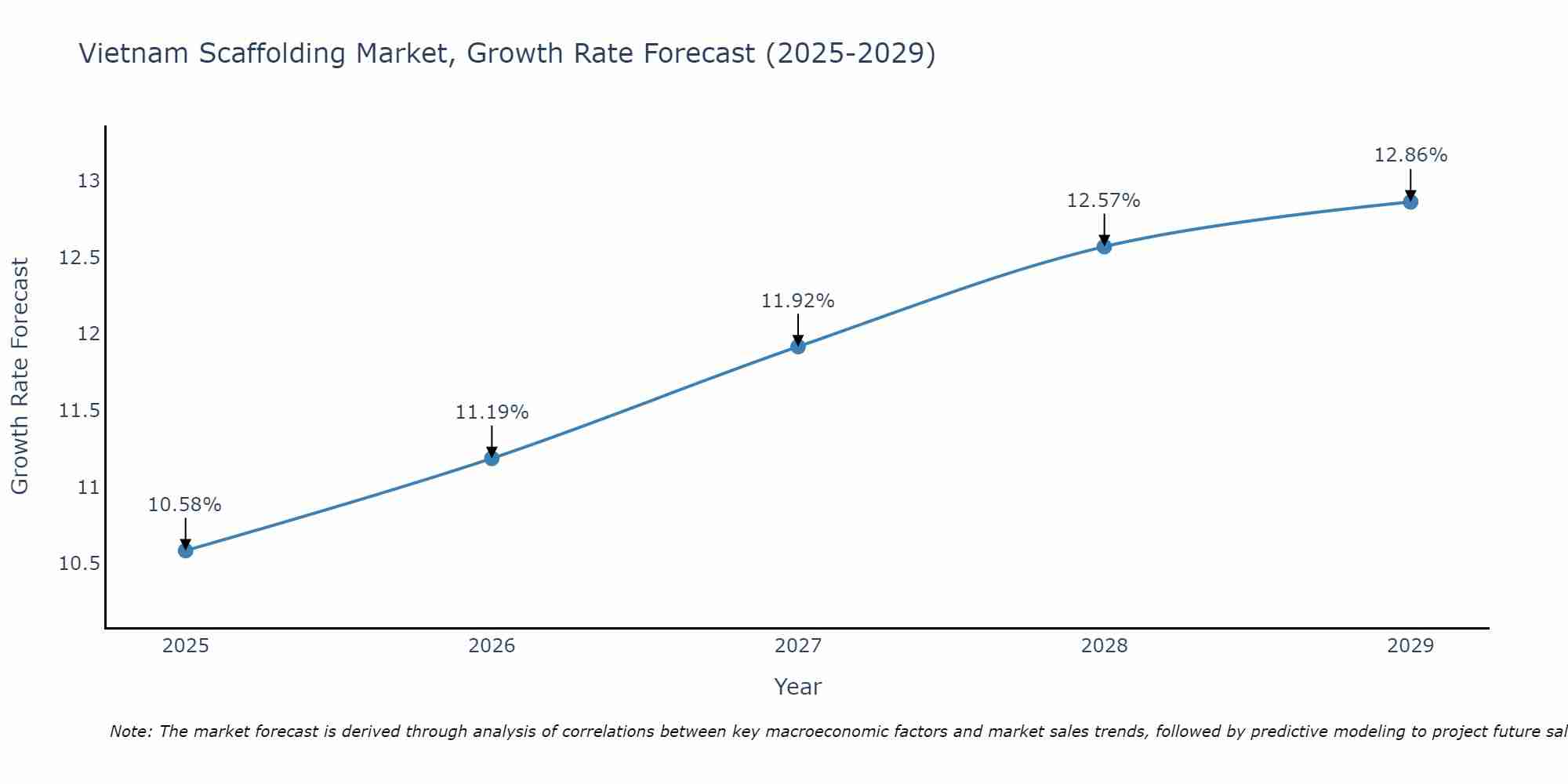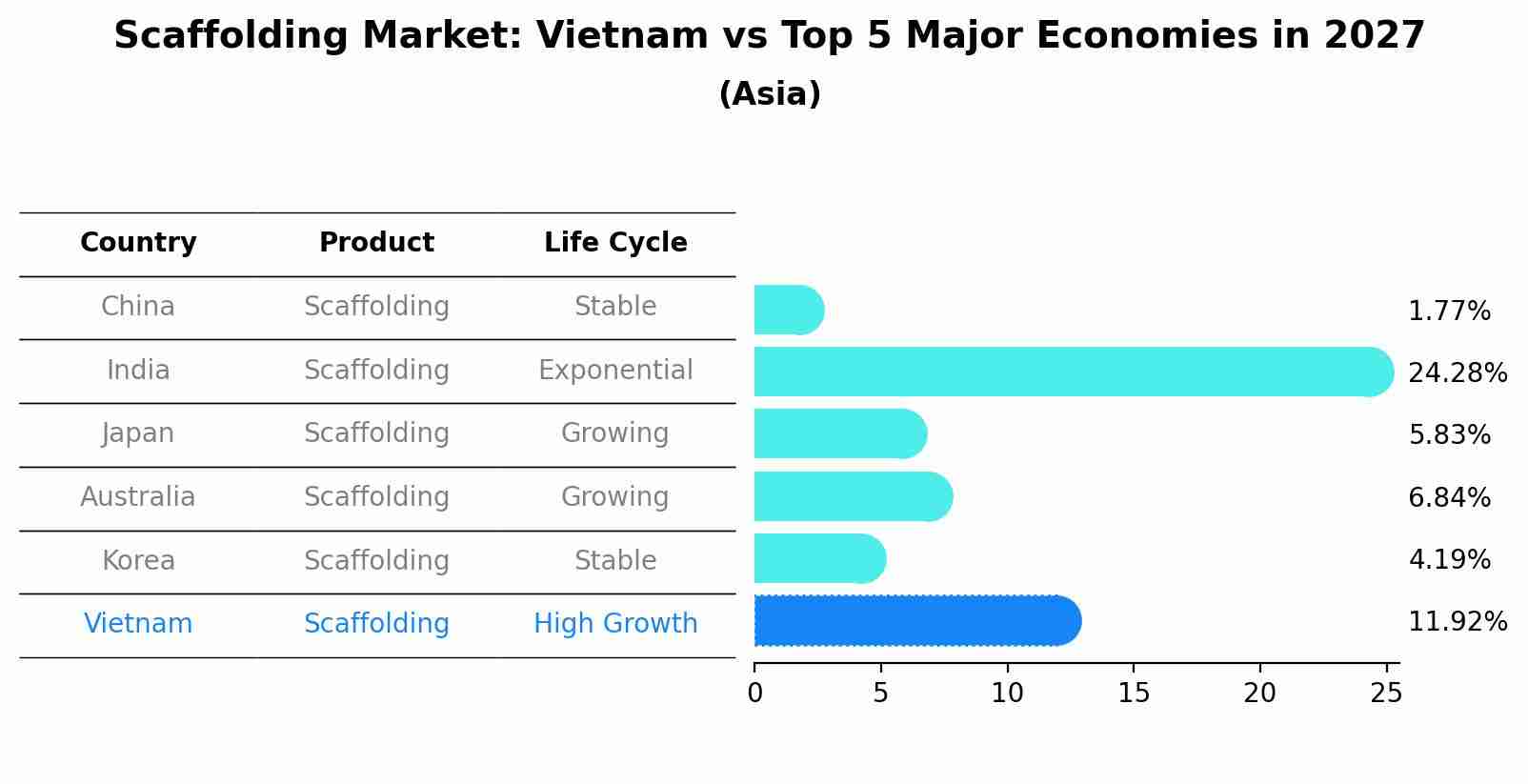Vietnam Scaffolding Market (2025-2031) Outlook | Companies, Value, Trends, Revenue, Growth, Industry, Analysis, Forecast, Share & Size
| Product Code: ETC377790 | Publication Date: Aug 2022 | Updated Date: Apr 2025 | Product Type: Market Research Report | |
| Publisher: 6Wresearch | Author: Ravi Bhandari | No. of Pages: 75 | No. of Figures: 35 | No. of Tables: 20 |
Vietnam Scaffolding Market Size Growth Rate
The Vietnam Scaffolding Market is poised for steady growth rate improvements from 2025 to 2029. From 10.58% in 2025, the growth rate steadily ascends to 12.86% in 2029.

Scaffolding Market: Vietnam vs Top 5 Major Economies in 2027 (Asia)
The Scaffolding market in Vietnam is projected to grow at a high growth rate of 11.92% by 2027, within the Asia region led by China, along with other countries like India, Japan, Australia and South Korea, collectively shaping a dynamic and evolving market environment driven by innovation and increasing adoption of emerging technologies.

Vietnam Scaffolding Market Synopsis
The Vietnam scaffolding market is closely linked to the construction and maintenance of buildings and infrastructure. Scaffolding provides temporary support and access for workers in construction and repair projects. In Vietnam, where the construction sector has been thriving, the demand for scaffolding systems has been steadily increasing. As urbanization and industrialization continue, construction activities are expected to remain robust, ensuring a sustained demand for scaffolding. The market comprises various types of scaffolding, including tubular scaffolding, frame scaffolding, and mobile scaffolding, catering to different project requirements.
Drivers of the Market
The Vietnam scaffolding market is thriving due to the ongoing construction boom in the country. With numerous infrastructure projects, both residential and commercial, scaffolding is essential for safe and efficient construction. Government initiatives to improve housing and infrastructure are propelling the demand for scaffolding. Moreover, safety regulations and the need to adhere to international construction standards are boosting the market as well.
Challenges of the Market
The scaffolding market in Vietnam encounters challenges related to safety regulations, material availability, and competition. Safety is a top priority in the scaffolding industry, and compliance with strict safety standards is essential. Managing the cost and availability of scaffold materials, such as steel and aluminum, can impact production costs and pricing. Moreover, competition among domestic and international scaffolding manufacturers requires constant innovation and differentiation to maintain market share.
COVID-19 Impact on the Market
The COVID-19 pandemic had a significant impact on the Vietnam scaffolding market. Construction activities, which are the primary users of scaffolding, were disrupted during lockdowns and restrictions. This led to a decrease in demand, and many construction projects were delayed. The market`s recovery was closely tied to the resumption of construction activities and government support for the construction sector.
Key Players in the Market
In the Vietnam scaffolding market, several key players have contributed to the construction and maintenance of buildings and infrastructure. Layher Vietnam, a subsidiary of the German scaffolding manufacturer Layher Group, has been a major player in providing high-quality scaffolding solutions. The company`s commitment to safety and innovation has made it a trusted partner in the construction industry. Another significant player is Haki Vietnam, specializing in scaffolding systems designed for flexibility and efficiency in various construction projects. Local companies like Dai Duong Company have also played essential roles in supplying scaffolding to meet the diverse needs of the Vietnamese construction sector. These leading players have not only focused on meeting safety standards but have also contributed to the development of advanced scaffolding technologies in the Vietnam scaffolding market, supporting construction projects across the country.
Key Highlights of the Report:
- Vietnam Scaffolding Market Outlook
- Market Size of Vietnam Scaffolding Market, 2024
- Forecast of Vietnam Scaffolding Market, 2031
- Historical Data and Forecast of Vietnam Scaffolding Revenues & Volume for the Period 2021-2031
- Vietnam Scaffolding Market Trend Evolution
- Vietnam Scaffolding Market Drivers and Challenges
- Vietnam Scaffolding Price Trends
- Vietnam Scaffolding Porter's Five Forces
- Vietnam Scaffolding Industry Life Cycle
- Historical Data and Forecast of Vietnam Scaffolding Market Revenues & Volume By Type for the Period 2021-2031
- Historical Data and Forecast of Vietnam Scaffolding Market Revenues & Volume By Supported Scaffolding for the Period 2021-2031
- Historical Data and Forecast of Vietnam Scaffolding Market Revenues & Volume By Suspended Scaffolding for the Period 2021-2031
- Historical Data and Forecast of Vietnam Scaffolding Market Revenues & Volume By Rolling Scaffolding for the Period 2021-2031
- Historical Data and Forecast of Vietnam Scaffolding Market Revenues & Volume By Material for the Period 2021-2031
- Historical Data and Forecast of Vietnam Scaffolding Market Revenues & Volume By Aluminum for the Period 2021-2031
- Historical Data and Forecast of Vietnam Scaffolding Market Revenues & Volume By Wood for the Period 2021-2031
- Historical Data and Forecast of Vietnam Scaffolding Market Revenues & Volume By Steel for the Period 2021-2031
- Historical Data and Forecast of Vietnam Scaffolding Market Revenues & Volume By End User for the Period 2021-2031
- Historical Data and Forecast of Vietnam Scaffolding Market Revenues & Volume By Residential for the Period 2021-2031
- Historical Data and Forecast of Vietnam Scaffolding Market Revenues & Volume By Commercial for the Period 2021-2031
- Historical Data and Forecast of Vietnam Scaffolding Market Revenues & Volume By Industrial for the Period 2021-2031
- Vietnam Scaffolding Import Export Trade Statistics
- Market Opportunity Assessment By Type
- Market Opportunity Assessment By Material
- Market Opportunity Assessment By End User
- Vietnam Scaffolding Top Companies Market Share
- Vietnam Scaffolding Competitive Benchmarking By Technical and Operational Parameters
- Vietnam Scaffolding Company Profiles
- Vietnam Scaffolding Key Strategic Recommendations
Frequently Asked Questions About the Market Study (FAQs):
- Single User License$ 1,995
- Department License$ 2,400
- Site License$ 3,120
- Global License$ 3,795
Search
Thought Leadership and Analyst Meet
Our Clients
Related Reports
- Canada Oil and Gas Market (2026-2032) | Share, Segmentation, Value, Industry, Trends, Forecast, Analysis, Size & Revenue, Growth, Competitive Landscape, Outlook, Companies
- Germany Breakfast Food Market (2026-2032) | Industry, Share, Growth, Size, Companies, Value, Analysis, Revenue, Trends, Forecast & Outlook
- Australia Briquette Market (2025-2031) | Growth, Size, Revenue, Forecast, Analysis, Trends, Value, Share, Industry & Companies
- Vietnam System Integrator Market (2025-2031) | Size, Companies, Analysis, Industry, Value, Forecast, Growth, Trends, Revenue & Share
- ASEAN and Thailand Brain Health Supplements Market (2025-2031) | Strategy, Consumer Insights, Analysis, Investment Trends, Opportunities, Growth, Size, Share, Industry, Revenue, Segments, Value, Segmentation, Supply, Forecast, Restraints, Outlook, Competition, Drivers, Trends, Demand, Pricing Analysis, Competitive, Strategic Insights, Companies, Challenges
- ASEAN Bearings Market (2025-2031) | Strategy, Consumer Insights, Analysis, Investment Trends, Opportunities, Growth, Size, Share, Industry, Revenue, Segments, Value, Segmentation, Supply, Forecast, Restraints, Outlook, Competition, Drivers, Trends, Demand, Pricing Analysis, Competitive, Strategic Insights, Companies, Challenges
- Europe Flooring Market (2025-2031) | Outlook, Share, Industry, Trends, Forecast, Companies, Revenue, Size, Analysis, Growth & Value
- Saudi Arabia Manlift Market (2025-2031) | Outlook, Size, Growth, Trends, Companies, Industry, Revenue, Value, Share, Forecast & Analysis
- Uganda Excavator, Crane, and Wheel Loaders Market (2025-2031) | Strategy, Consumer Insights, Analysis, Investment Trends, Opportunities, Growth, Size, Share, Industry, Revenue, Segments, Value, Segmentation, Supply, Forecast, Restraints, Outlook, Competition, Drivers, Trends, Demand, Pricing Analysis, Competitive, Strategic Insights, Companies, Challenges
- Rwanda Excavator, Crane, and Wheel Loaders Market (2025-2031) | Strategy, Consumer Insights, Analysis, Investment Trends, Opportunities, Growth, Size, Share, Industry, Revenue, Segments, Value, Segmentation, Supply, Forecast, Restraints, Outlook, Competition, Drivers, Trends, Demand, Pricing Analysis, Competitive, Strategic Insights, Companies, Challenges
Industry Events and Analyst Meet
Whitepaper
- Middle East & Africa Commercial Security Market Click here to view more.
- Middle East & Africa Fire Safety Systems & Equipment Market Click here to view more.
- GCC Drone Market Click here to view more.
- Middle East Lighting Fixture Market Click here to view more.
- GCC Physical & Perimeter Security Market Click here to view more.
6WResearch In News
- Doha a strategic location for EV manufacturing hub: IPA Qatar
- Demand for luxury TVs surging in the GCC, says Samsung
- Empowering Growth: The Thriving Journey of Bangladesh’s Cable Industry
- Demand for luxury TVs surging in the GCC, says Samsung
- Video call with a traditional healer? Once unthinkable, it’s now common in South Africa
- Intelligent Buildings To Smooth GCC’s Path To Net Zero


















